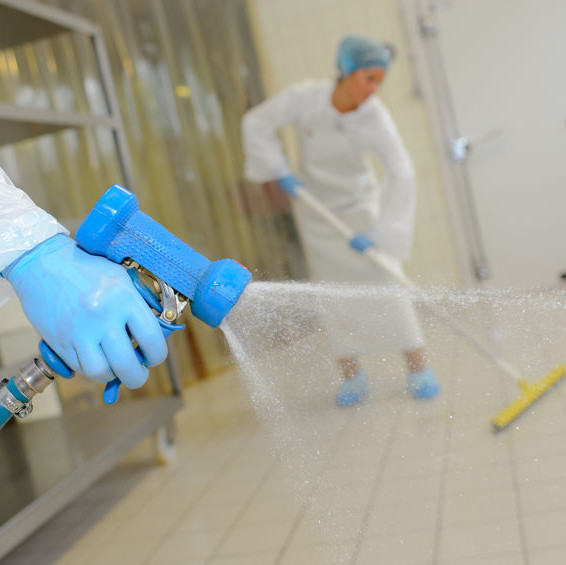Sanitary Design
What is sanitary design?
Sanitary design is a set of standards and conditions related to food hygiene. Food plants use sanitary design to prevent physical, chemical, and biological contamination of food. It is a prerequisite program that makes it easier to perform all the tasks within a food plant.
Sanitary design helps food plants to produce safe and high-quality products. It is a broad food safety concept that encompasses:1
- Buildings’ design and construction
- Internal divisions’ design/layout (segregation of facility areas)
- Food processing equipment and machinery
- Ancillary equipment (e.g., CIP skids)
- Provide maximum protection to the food products from physical, biological, and chemical hazards
- Facilitate access for inspection, cleaning, sanitation, lubrication, and maintenance of food processing and ancillary equipment, and nonfood contact surfaces, i.e., buildings
- Ensure drainability for flooring and product-holding equipment
Sanitary design focuses on:2
- Materials of construction for food and nonfood contact surfaces (e.g., metals, plastics, composites, elastomers)
- Design and fabrication of food and nonfood contact surfaces
Regulatory compliance3
Sanitary design of food plants is under control of 21 CFR Part 117. This rule states that:
- The plant must be suitable in size, construction, and design to facilitate performing the normal operations (i.e., manufacturing, processing, cleaning and sanitation of utensils, equipment and personnel, packaging, and holding of products).
- The construction and design of the plant must permit the taking of adequate precautions to reduce the potential for allergen cross-contact and for contamination of food, food-contact surfaces, or food-packaging materials with microorganisms, chemicals, filth, and other extraneous material.
- Buildings, fixtures, and other physical facilities of the plant must be maintained in a clean and sanitary condition to prevent food from becoming adulterated.
- Food contact surfaces used for manufacturing/processing, packaging, or holding food must be in a clean, dry, sanitary condition before use.
- Equipment that does not come into contact with food must be so constructed that it can be kept in a clean and sanitary condition.
Relevance
The food industry faces increasing controls regarding food safety matters every day. Traditional good manufacturing practices and the prerequisite programs are now accompanied by new ones that aim to strengthen the efforts made by companies to process foods in the most hygienic way possible.
Sanitary design emerges as a prerequisite program that deals with buildings, facility layout, and equipment used for the processing, packaging, and storage of foods. This program allows proactive and preventive management of physical, chemical, and biological hazards.
A sanitary design program articulates different management areas and requires the company departments, e.g., purchasing and procurement, production, maintenance, civil works, and quality management, to work together in designing and implementing hygienic measures to ensure the suitability of production processes, as well as other measures related to the value chain.
Application
Sanitary design can be applied to:
- Layout and flow pattern design of processing and warehousing areas
- Nonfood contact surfaces, i.e., buildings (for example, floors, walls, doors, ceilings, loading/unloading docks, electrical systems/cabling, plumbing, toilet rooms, and lighting)
- Food-processing equipment (e.g., storage tanks, mixers, extruders, heat exchangers, ovens, conveyors)
- Ancillary equipment (e.g., HVAC, air compressors, valves, instrumentation and control devices such as manometers and thermocouples, piping fittings, pumps, air/water filters).1
Sanitary design requires that construction material for food-processing equipment and nonfood surfaces be durable, smooth, drainable, easily cleanable, non-absorbent, non-toxic, non-corrosive, and properly welded to prevent ingredient or product buildup and biofilm formation.
The following components must be included and considered in the sanitary design of food processing equipment, as any of these could represent a food safety hazard:
|
|
Components of a sanitary design program
- Engineering and hygienic design manuals containing appropriate standards and guidelines for the sanitary construction of building components
- Engineering and hygienic design manuals containing appropriate specifications and guidelines for the purchasing/approval of new utensils, food-processing, and ancillary equipment.
- Auditing and third party certification of processing equipment by worldwide authorities regarding hygienic design of food processing equipment, e.g., 3-A Sanitary Standards, Inc., The European Hygienic Engineering and Design Group (EHEDG), Baking Industry Sanitation Standards Committee (BISSC), and ISO.
The Sanitary Design Program is completely compatible with the Metal-to-Metal and Maintenance programs, since all three deal with facility infrastructure and food processing equipment.
References
- AIB International. “Food Safety and Sanitation Distance Learning Course, Chapter 8, “Sanitary Design.”
- Lelieveld, H.L.M., et al. “Hygiene in Food Processing: Principles and Practice.” Hygienic Design of Food Processing Equipment, 2nd ed., Woodhead Publishing Limited, 2014, pp. 91–95.
- U.S. Food and Drug Administration. “21 CFR 117 – Current Good Manufacturing Practice, Hazard Analysis, and Risk–based Preventive Controls for Human Food.” 1 Apr. 2017, https://www.accessdata.fda.gov/scripts/cdrh/cfdocs/cfcfr/CFRSearch.cfm?fr=117.130.


